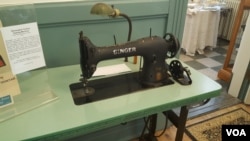In a well-lit, air-conditioned and humidity-controlled room, a group of volunteers are dedicating their time and sewing skills to preserve history. They sort, repair, document and preserve old, used clothing and accessories.
Old garments and history
The Historical Society of Harford, Maryland, has been collecting locally significant artifacts since it was founded 132 years ago. "It's part of our social history," says Society board member, Betsy Lehmann. "How people dressed, what it indicated. I think it's as much part of our history as documents from our past."
Clothing is donated by local families who may have kept them for generations before deciding it was time to let them go.
WATCH: Preserving history with needle and thread
Lehmann and other volunteers carefully sort through the clothes to decide what can be saved.
“A number of us had been to textile conservation conferences to learn how to preserve pieces,” she explains. “You got to take a piece out and assess it and decide if it has any moth (damage). They can be vacuumed they can be, if washable, they can be washed carefully. Some sewing and restoration might be needed to stabilize a piece.”
To protect the garments from further disintegration, volunteers use acid-free tissue paper and boxes for storing. Some of these pieces are much older than the society itself.
“We have everything from late 1700s, a few pieces from around 1830 or so,” Lehmann says. “Then, as time progresses into, say, the Civil War era and forward, we have a lot more pieces, quite a nice collection going up to say 1970s or so.”
Unlocking secrets
With patience, passion and some detective work, volunteers unlock the secrets behind each item.
“Today you can find everything on the Internet,” Lehmann points out. “We have some books that we use. When we really get unsure about something and we have some time and financial ability, we hire a professional who is very good at documenting pieces. The lady we work with can tell something from1870s as opposed to something from 1880s.”
Lehmann says old clothes speak volumes about the society of the people who wore them, when clothing was not as disposable as it is today.
“I think it tells us that people always cared about their appearance. They cared about what they wore. They cared about how their homes looked. This is all part of their life and how they expressed their personalities.”
Preserving history
“We try to preserve (history) so people going forward in essence will know where they came from, where our town and county came from, what our background is and how that helped us become who we are today,” says the Society's director, Maryann Skowronski. Textile preservation is just one of the tools they use to do that. “We have huge collections. We have actually any paper items you can imagine, objects, artifacts. We have photographic collection. Our photographic collection is over 11,000 individual photographic images.”
People visit the old post office building that now houses the Historical Society of Harford for many reasons.
“I would say probably most people that come here are trying to do research on their family history, their background (and) their ancestors,” Skowronski says. “We have researchers that are coming here writing papers. We have requests from not only local, but throughout the U.S. We had requests from overseas as well. Whenever we have a visitor coming here for the first time, we try to give them a tour. We do not like to hand people a file catalogue and say here is your topic.”
Ten-year old Tylor Deitrick, who visited with his family, says he liked the historic photographs and old documents. “I like history more, I liked it a lot before though.”
Teacher and mother of two, Lea Bosnak, enjoyed seeing the various collections on display. But she loved the textile collection the most. “I love seeing old clothes. My mother is a seamstress, so I can appreciate the time it takes to create something like that, especially the intricate work that they have done, but to preserve that is very impressive too.”
Museum look
Director Skowronski says the Historical Society of Harford has ambitious plans.
“We're actually working on the very early stage of plans to design a more museum face because right now the building is primarily a research facility. We don't have much space in this building to showcase the collections, so we're actually in the process of meeting with museum designers who are going to analyze the space. So we're hopeful that in the next several years this venue will change and we'll have a lot of our collections out in public.”
The goal is to give visitors, especially young people, a chance to learn about social history. That is what motivates volunteers and keeps them working hard to preserve every piece and thread of their county's past.

